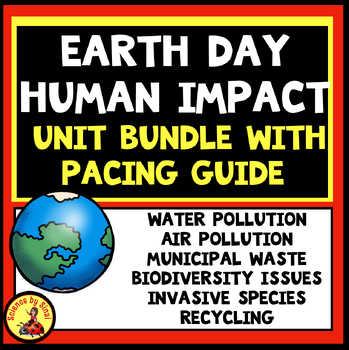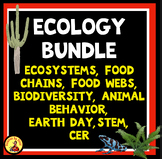HUMAN IMPACT AND EARTH DAY UNIT BUNDLE With Pacing Guide MS-ESS3-3, MS-LS2
- Zip
Products in this Bundle (15)
showing 1-5 of 15 products
Also included in
- After teaching science for over 30 years, I finally put together my middle school and upper elementary ecology and environmental science, ecosystems, food chains and webs, biodiversity, Earth Day, STEM and CER resources! Click on the preview for complete details!The resources range from interactivePrice $252.60Original Price $315.75Save $63.15
Description
Here is my 2-3 week unit bundle for teaching Human Impact and Earth Day as part of MS-ESS3-3, MS-LS2-3 and MS-LS2-4. Easy prep activities. There is a detailed pacing guide that also includes links to my blog posts that helps you build out each activity. Please see the detailed preview.
Topics Include:
Interconnected Food Webs
Abiotic and Biotic Components
Manmade or Natural Events Affect Food Webs
Design a Water Filter
Use Pond Water Microorganisms as Bioindicators of Water Pollution
Determine the Ratio of Product to Packaging in terms of Municipal Waste
Go on a Recyclable Plastic Scavenger Hunt
Graph the Types of Trips the Family Car Takes as Part of Study on Air Pollution
Research Project on an Invasive Species
Play Food Web Dice Roll Games about the Affect of Invasive Species on The Desert, Rainforest and Deciduous Forest
Play Biodiversity Board Games on the Desert and Rainforest
Are you looking for other science resources? NGSS aligned activities? Science classroom decor or clip art? Please check out the rest of my store at SCIENCE BY SINAI.
https://www.teacherspayteachers.com/Store/Science-By-Sinai
Follow Me
Do you want to be the first to find out when I post a new resource? Please click on the green star next to my name to FOLLOW MY STORE, SCIENCE BY SINAI, and to get an email each time I post a new product. As a follower you will also get notifications of freebies and sales!
Check me out on social media.
https://www.pinterest.com/karensinai2/
https://www.instagram.com/sciencebysinai/
https://www.facebook.com/Science-by-Sinai
***CHECK OUT MY BLOG FOR EXCLUSIVE FREEBIES! https://sciencebysinai.com
Feedback
**Did you know that you can save money on TpT resources by leaving feedback? Go to your “My Purchases“ page and leave feedback on the resources you’ve purchased to earn TpT credits!
Copyright.
Each purchase is a license for ONE person to use in a classroom setting. It is a violation for individuals, schools and districts to redistribute, edit, sell, or post this item on the Internet or to other individuals. Disregarding the copyright is a violation of the Digital Millennium Copyright Act and subject to legal action. By purchasing this product you acknowledge that you have read and understood these terms of use.






